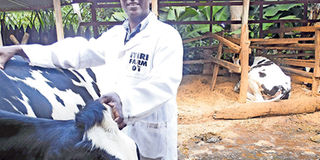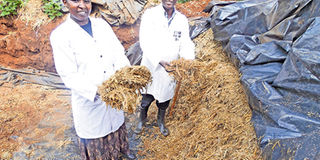Why my cows won’t starve during Covid-19 pandemic

Farmer Timothy Mwirigi, the owner of the dairy farm named Itiri in Meru County. The new coronavirus disease added a burden on farmers as cost of feeds rise amid the various measures being implemented to curb its spread. But farmers like Mwirigi, who had planned well, are having it much easier. PHOTO | CAROLINE WAMBUI | NATION MEDIA GROUP
What you need to know:
- Timothy Mwirigi stored 140 tonnes of silage to cushion himself from climate change effects; the move has turned out to be a huge blessing during Covid-19 pandemic.
- A quarter-acre hosts the animals and their sheds and a store, where he places various farm implements and bales of hay, of which he now has 100.
- While storing the feed, Mwirigi was seeking to cushion himself from the effects of climate change, with the country having recently experienced devastating dry spells.
- To ensure he has adequate feeds, Mwirigi leases at least five acres at Sh5,000 each a year where he plants maize for ensiling.
In one section of a dairy farm in Meru, two huge silage bags sit pretty in an enclosure, with the farmer waiting for an opportune time to open them.
Not far from the sacks are other feed storage facilities, several underground bunkers hosting tonnes of silage.
Farmer Timothy Mwirigi (42), the owner of the dairy farm named Itiri, 5km from Kariene market, says the feeds will last him more than a year.
“I have 140 tonnes of silage for my 22 animals, which is more than enough. I am not worried about feeds currently,” says Mwirigi, who farms on half an acre.
A quarter-acre hosts the animals and their sheds and a store, where he places various farm implements and bales of hay, of which he now has 100.
On the other quarter-acre, he preserves his feeds in nine underground bunkers each measuring an average of 3m by 7m with a depth of 1m, which hold the tonnes of maize silage.
“I also have two surface bunkers hosting eight tonnes and two silage bags holding some two tonnes. The silages are of different ages; there is one I ensiled in January and the oldest was done in 2017,” says Mwirigi, who started making silage in 2014, noting the feed is much affordable than hay which is currently being sold at Sh300 a bale.
While storing the feed, Mwirigi was seeking to cushion himself from the effects of climate change, with the country having recently experienced devastating dry spells.
“The harsh effects of climate change prompted me to strategise on how to feed my animals since it had become hard to predict the weather. Heavy rains, drought, floods and now locusts seem to be the new norm.”
REMAINS FRESH FOR YEARS
The new coronavirus disease (Covid-19) has added the burden on farmers as cost of feeds rise amid the various measures being implemented to curb the spread of the virus. But farmers like Mwirigi, who had planned well, are having it much easier.
“Animals will feed even during times of calamities thus the farmer must always plan. My mantra is to have fodder whether there is rain or shine.”
To ensure he has adequate feeds, Mwirigi leases at least five acres at Sh5,000 each a year where he plants maize for ensiling.
He then harvests the plants at dough stage, that is when the grain is not too milky, and uses a fodder shredder to slice them.

Mwirigi with his wife Josephine Kinya in one of the bunkers in which they store silage in their Meru farm. He says he currently has up to 140 tonnes of silage for his 22 animals. PHOTO | CAROLINE WAMBUI | NATION MEDIA GROUP
“I carry the machine to the farm where the fodder is cut and shredded right into the lorry and is ensiled the following day. I rarely use molasses — if you harvest the plants at the right stage, you avoid using molasses as maize has enough sugars,” he offers.
One of his strategies is that he does not wait for all the bunkers to be depleted for him to ensile. “Every time a bunker is emptied, I ensure I restock it to lessen the burden of filling all of them at the same time,” explains Mwirigi, who ventured into dairy farming after quitting the hotel industry
So how does he ensure the silage remains fresh for years and rodents don't get in? “The bunker is sprayed with an insecticide before ensiling takes place and it is well covered and compacted. Once it is opened, the feeds are used until they are over to avoid formation of moulds.”
QUALITY CARE
Mwirigi observes that silage requires quality care during storage to prevent any deterioration. “Rats, birds, insects and fungi are some of the enemies of silage during storage.”
To maximise space on his farm, he plants sweet potato vines on top of the bunkers, with the crop not only acting as a cover crop that prevents soil erosion, but they are also a source of protein for the animals as he uses them alongside silage.
He has also surrounded the bunkers with other fodder crops like napier, desmodium, lucerne and calliandra.
Mwirigi feeds his animals once a day, that is, at 6am after milking.
“We do manual milking from about 5.30am, then at 1pm and 8pm and get an average of 250 litres a day, which I sell to Meru Union currently at Sh32 a litre,” says Mwirigi, noting he also offers farmers training at Sh500 per person but Covid-19 has curtailed the business.
Phillip Oketch, a livestock specialist with SNV in Meru, notes fodder storage acts as insurance against economic losses and is part of good herd management.
He notes that farmers who had not planned well are now straining due to restrictions in some counties, which have made access to fodder and even commercial feeds a challenge.
“Covid-19 is frustrating farmers and cooperatives in a big way. Some farmers have been laid off and with the need for quick money for survival, they have turned to selling their milk to hawkers, who pay promptly, meaning that cooperatives are not getting milk in full capacity since the societies pay at the end of the month.”
****
Get it fast
Keeping covid-19 at bay on the farm
- Sanitise everyone who visits the farm, including workers and yourself and family members.
- Have several handwashing points on the farm.
- Have foot baths that everyone must use before getting into the cowsheds and the farm.
- Wear a mask when in the cowsheds to protect the animals and maintain social distancing.
- Increase the frequency of cleaning the cowsheds. If you used to do it once a day, you can now clean them twice daily with recommended disinfectant.


